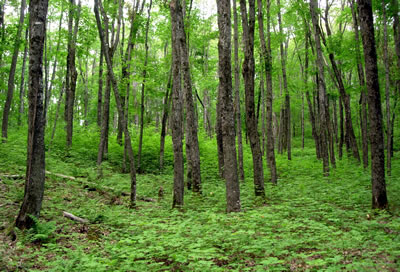Site Description
This IBA encompasses the geological feature known as the Blue Hills, an area of rugged topography composed of very resistant underlying quartzite. Most of the land is now in county forest, and the landscape is largely forested, with both young and mature forests of oaks, aspen, and maples in the uplands and bottomland hardwoods, lowland brush, and scattered conifer bogs in the lowlands. Also present are mixed hardwood-conifer forest, areas of mature conifers, cool-season grasslands, and many streams.
Ornithological Importance
This extensive forested landscape provides habitat for many forest birds, including significant suitable habitat for cerulean warbler. Other high-priority breeders include least flycatcher, yellow-throated vireo, wood thrush, and black-throated blue warbler. Bog relicts provide for Nashville warbler, Northern waterthrush, pine warbler, and Lincoln’s sparrow.

Blue Hills, photo by Ryan Brady